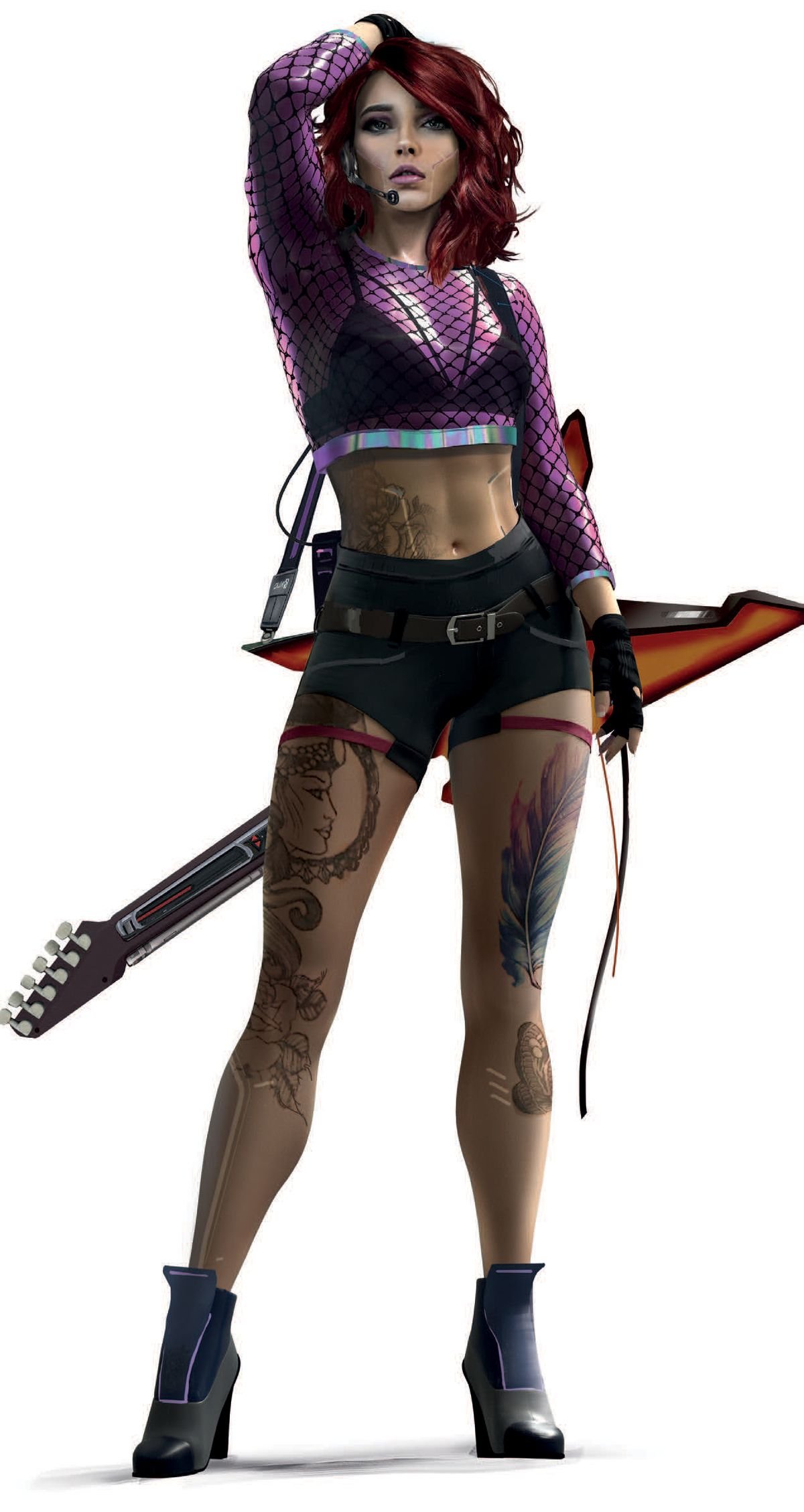Cyberpunk Red, the latest tabletop role-playing game from R. Talsorian Games, is big and brash. The 458-page volume is much more than a game manual. It’s also a collection of short stories, vignettes that cut to the core of a glitzy dystopian world that’s reached a point of equilibrium between an ongoing crisis and an outright disaster.
It also manages to fully flesh out the systems only hinted at in the Cyberpunk Red Jumpstart Kit, released in the summer of last year. It’s a solid tabletop RPG, perfect for making a great one-shot or kicking off an epic campaign. For eager fans champing at the bit for a taste of Cyberpunk 2077, it also serves as the perfect prequel to the year’s most anticipated video game.
Of course, it’s not all new material here as far as backstory goes. If you’ve read my review of the Jumpstart Kit, you can expect the fluff and the art to be substantially expanded and well worth your time — even just as a coffee table book. What’s so striking about the Cyberpunk Red rulebook as a document is just how readable it is.
R. Talsorian has crafted it like a magazine — big friendly text bracketed with in-fiction slang and embedded ads (but not too many). There’s also a Starship Troopers-style ethos throughout, with bold text that gets called out in a glossary at the back and a bevy of page numbers mentioned as asides so you can skip ahead if you’d like to know more. It straddles the line between a good read in and of itself and a reference manual in ways that publishers like Wizards of the Coast (Dungeons & Dragons) and Paizo (Pathfinder, Starfinder) can only dream of.
But really, it’s Cyberpunk’s slyness about its vision of the future that sells the whole package. This version of the tabletop game isn’t a relic of the 1980s with a fresh coat of paint. Likewise, it’s not a ripped from-the-headlines tabloid goof meant to be disposable. It’s a continuation of a franchise with a rebellious, counter-culture point of view. Cyberpunk Red pushes its own alternate future timeline forward far enough to remain different and exciting when compared to our own, while remaining a funhouse mirror image of the same troubled world we still live in.

“Remember; the Cyberpunk future is a warning; not an aspiration,” wrote creator Mike Pondsmith in June, as the United States erupted in massive protests triggered by the police killing of George Floyd. “Whether we hear the warning is up to you.” The modern labor and class struggles, sexual politics, issues of equality, democracy, and tyranny are all represented on this book’s pages — and used as inspiration for hooks that can inspire compelling player-generated content.
Best of all are the gritty bits of game mechanics that occupy the middle third of the book. I’m specifically talking about the revamped combat system (called Friday Night Firefight) and the evocative new rules for hacking (known as Netrunning).
Unlike the character generation system in Cyberpunk Red — which is filled with dozens of tables and flowcharts that allow players to create myriad different personalities — aiming and firing a gun in the game is fairly straightforward. A single, one-third page table handles ballistic engagements from zero out to 800 yards with all of the game’s major weapon systems. If that’s all you want to worry about as the game master (GM), it would be easy to leave it at that.
But, Cyberpunk Red lets players go even deeper. There are rules for weapons with multiple fire modes, for arrows and thrown explosives, and for players who want to bring their knives to a gunfight. There are rules for critical injuries, rules for destructible terrain, and rules for fighting from and with vehicles. The game system gets more done in roughly 70 pages than some miniatures skirmish games do in entire splatbooks.
Most exciting of all are the finalized rules for Netrunning. Hacking in the world of Cyberpunk Red is about navigating a linked series of mini-games that exist within the larger game itself. Players use press-your-luck style dice mechanics to navigate its complex puzzles.

Netrunning is evocative, a parallel virtual world filled with slavering code-based attack dogs and floating cyber ninjas. Testing it out during a demo game with co-author Cody Pondsmith as the GM, I didn’t feel like a wizard casting Magic Missile over and over again, nor did I feel like I was trapped inside Lawnmower Man. Encounters with programs and other Netrunners were quick, tense, and required a strategic mind. It also didn’t slow things down for everyone else at the table, which kept the action moving.
Those new to the hobby, or those coming from other products like D&D or Pathfinder, will find a decently high learning curve — especially if you’re running the game. To present a good, tactical game of Cyberpunk Red, GMs will need to come up with more than just a simple grid of one-inch squares and a handful of non-player characters. There’s also a whole other landscape that’s invisible to every other player at the table besides the party’s Netrunner. Making that space just as exciting as the “real” world the rest of your players exist in is a tall order, while blending the two layers together into something dramatic is harder still. Cyberpunk Red gives good advice for accomplishing both.
More interesting is the inclusion in Cyberpunk Red of a kind of in-game post-traumatic stress disorder. Empathy is an in-game statistic that players will track on their stat sheet, and accounts for the individual player’s level of humanity. Cybernetic implants, drug use, as well as major physical and mental traumas encountered during a gameplay session all whittle away at a character’s mental stability. Expect to make a few dice rolls to see how your between-game therapy impacts your character’s mental state before the next session.

The chapters on therapy and “cyberpsychosis” as it’s called are easy sections of the book to skip, especially if it detracts from your personal sense of escapism. It’s also an opportunity for R. Talsorian to emphasize the concept of “lines and veils” — a common strategy of keeping players safe at the table when the game moves toward uncomfortable or triggering subjects. Unlike Vampire: The Masquerade’s 5th edition, which overtly includes sensitive issues like sexual violence and consent, there’s little of that kind of content in the core gameplay loop of Cyberpunk Red. But keeping player safety top of mind is good tradecraft, and the writers do a decent job of it here.
If I have any complaints, it’s that the book doesn’t come with all that much in the way of introductory adventures. While there’s plenty of discrete hooks and encounters, including instruction for fledgling GMs on how to use them, there’s not a ton of prefabricated gameplay. There are only three starting scenarios wedged into a slim 10-page section at the back of the book, and a lot of that content is one-page fluff documents intended to be handouts for players. That criticism aside, it’s a marvelous product overall and required reading — in my opinion — for building a character in CD Projekt Red’s upcoming Cyberpunk 2077.
Cyberpunk Red will go live as a $30 downloadable PDF on Nov. 14. Physical books should hit store shelves in the United States, and R. Talsorian’s own online storefront, Nov. 19 at $60. Cyberpunk 2077 was recently delayed — for a third time — until Dec. 10.
Cyberpunk Red was reviewed with a final PDF version provided by R. Talsorian Games. Vox Media has affiliate partnerships. These do not influence editorial content, though Vox Media may earn commissions for products purchased via affiliate links. You can find additional information about Polygon’s ethics policy here.















































